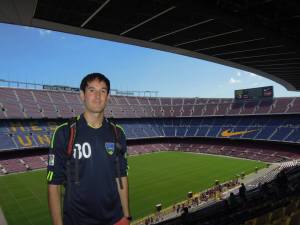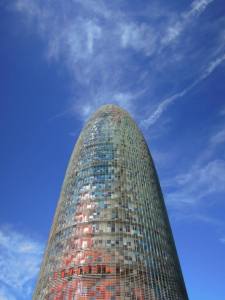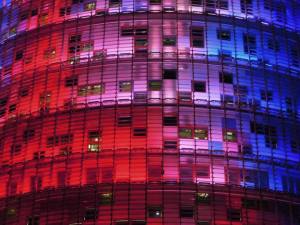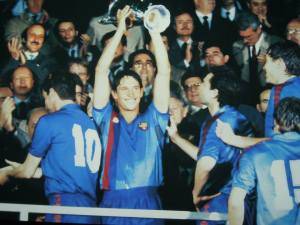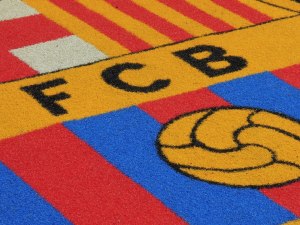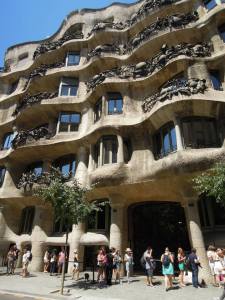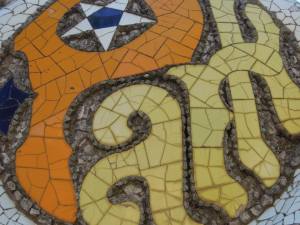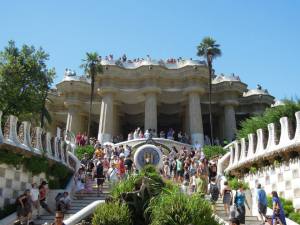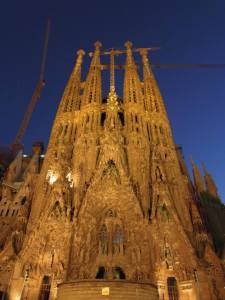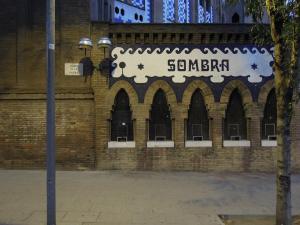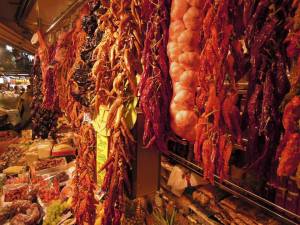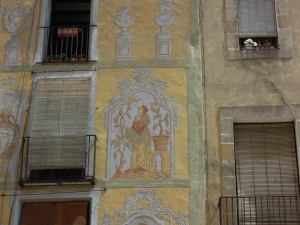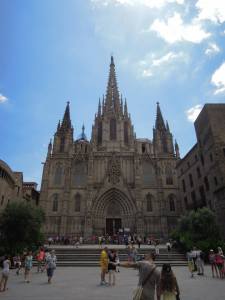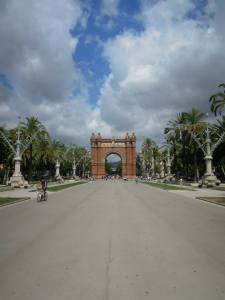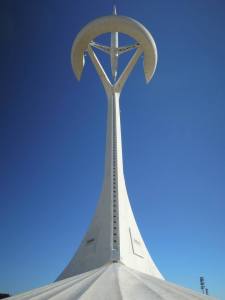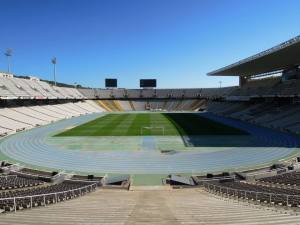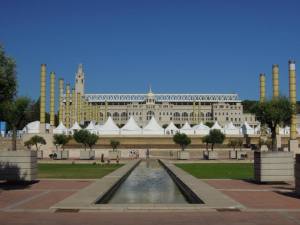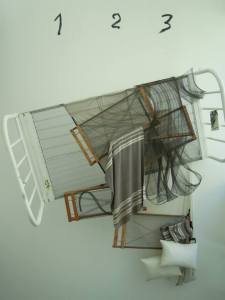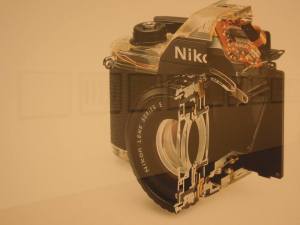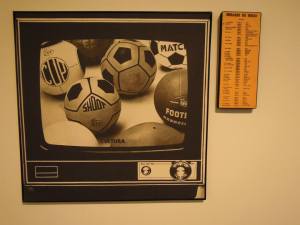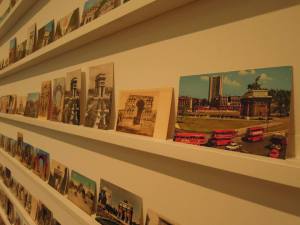Although three weeks in England was still in front of me the final part of my journey through Europe would be in Barcelona, the capital city of the autonomous community of Catalunya and the home of the most successful football club in the world. I had a few days before another budget airline flight would whisk me home to Exeter and the rolling Devonshire hills of home. After taking the intercity bus and checking into one of two hostels that I would stay at in Barcelona (places had booked up and I was struggling to get last-minute rooms) I took the remainder of the day to walk around the quiet area near my hostel, Poblenou, a burgeoning technical business area with some modern buildings like the dynamic and colorful Torre Gabar skyscraper. I had an amazing burger at a pub I have forgotten the name of, before getting to sleep pretty early for a full day of exploration around Barcelona the following day.
The majestic, dynamic and colourful Torre Agbar.
I woke the next day before beginning an archaic journey across the city using the subway system and following my internal man-compass that eventually got me to the shadows of the imposing Camp Nou. Deciding to splash out on a Camp Nou Experience ticket (23 €) that included a full tour of the stadium and admittance to the impressive Camp Nou interactive experience and the club museum. I would not recommend wearing a fake Real Madrid (away) shirt in the stadium complex, or even in the city at all, as it will attract a certain questionable glare and snear on occasion (see photo at the top of the page), its only redeeming feature being that it was my Changwon Wednesday kit from Korea. I would suggest that even if you are not a football lover that you still go to the Nou Camp, it appears expensive but the attention to detail, quality and quantity of exhibits really makes you understand the importance, both political and sporting of this great club in modern Spanish history. The actual stadium is incredible, too. I was absolutely gutted to discover that the day I left Barcelona would be the first pre-season home game against Santos of Brazil and I wouldn’t be able to experience being there on a match day. I guess I will have to go back sometime; maybe for Tottenham Hotspur vs Barcelona in the Champions League…?
Gary Lineker, my childhood hero at the peak of his playing days at FC Barcelona.
The club crest adoring the touch-line, (from top-left to bottom) the St George Cross, the Catalonia colours and the club colours.
After my footballing fix, I decided to explore some of Barcelona’s famous examples of “Modernisme” (Art Nouveau). In particular this meant a self-guided tour of Gaudi’s work around the city. Antoni Gaudi was the figurehead of Catalan modernism and integrated his distinct personal artistic skills in ceramics, stained-glass, wrought-iron forgery and carpentry into his outlandish and ambitious architectural projects. I walked outside two houses that have been turned into museums (over-priced ones) that are dedicated to his life and works ( La Pedera/ Casa Mila and La Casa Batllo) before walking to Park Guell, a public garden that is accented with architectural pieces from Gaudi’s rather exuberant imagination. Later in the evening I went to La Sagrada Familia, Gaudi’s overtly ambitious and iconic homage to his religious faith (it’s still being built 87 years after his death). The church, even when surrounded by giant cranes and building-works is one of the most bewildering and astonishingly impressive man-made objects I have seen.
Gaudi using one of his trademark techniques of using reclaimed ceramics in his architecture (trencadis) to mark the entrance to Park Guell.
Looking up to the main terrace of Park Guell and the zombie like mob of tourists.
Gettng a brief space from the tourist throng to take a picture from the roof terrace of Park Guell across Barcelona to the Mediterranean Sea.
La Sagrada Familia lit up at night.
Outside the now redundant Monumental Bullring of Barcelona, the Catalan government passed a bill banning bullfighting in 2010.
Casa Batllo with its decorative ceramic facade.
The next day was dedicated to a hostel transfer and a rather lazy ambling walk around the Ciutat Vuelta and the area that surrounds the popular Las Ramblas. Ciutat Vuelta (Catalan for Old City) is composed of four districts: The immediate coastal area of Barceloneta with its narrow streets and delis that hover behind a sandy beach. Barri Gotic, an area built on Roman foundations with imposing and sometimes leaning architecture and the inspiration for many artists and writers. La Ribera, an area of boutique shops, thriving nightlife a vibrant city park and the mandatory, ‘big city’, Arc de Triomf. Finally, there is the once notorious El Raval, an area to the west of the famous Las Ramblas, once a den of drugs and prostitution and other seedy happenings that has now been revitalised (following the 1992 Olympics) into a lightened, artistic and predominantly immigrant area.
The vibrant colours and smell from La Boqueria Mercat, a perfect stop for some refreshing juices and fruits on a hot day walking the streets of Ciutat Vuelta.
Some of the architectural styling that can be found in the Barri Gotic.
The Cathedral at the northern tip of the Barri Gotic.
La Ribera, the Arc de Triomf. I returned here later that evening on a run that encompassed several laps of the extremely social Parc de la Ciutadella. Both on the parade leading to the Arc and in the park, various groups of people were enjoying the idyllic summer evenings. In the increasingly long shadow of the Arc there was a group of Asian women practicing T’ai Chi, a team of rollerblading youths weaving a slalom course and a cluster of Capoeira dancers. As I lapped the park I was witness to numerous groups practicing various fitness techniques, extreme yoga, boxercise and circuit training. I don’t think I have ever seen such a diverse and vibrant dynamic anywhere else in the world.
On my final day in Barcelona I crossed the city and headed to Mount Montjuic. Mount Montjuic provides stunning views over the coastal city below and really gives you an idea about the diversity that Barcelona has to offer its residents and visitors. From the medieval fort that tops it you can see out across the beach lined coast, over to the mountains heading towards Montserrat, down into the busy container riddled port and over the Celta Vuitat.
The 100m track where Linford Christie raced to gold for Team GBR.
Not only a steep hill with a moated medieval fort atop, Mount Montjuic is also home to the 1992 Olympic Park. Unbeknown to me I arrived when the FINA World Championjships were taking place and many of the facilities were being used for the swimming gala. This meant I could almost appreciate what it would have been like to attend the Olympics. There were plenty of broad-shouldered athletes milling around (although I didn’t recognise a single one, it was swimming after all…), news agency vans, tented entertainment areas and event promotional material. Unfortunately, I couldn’t get a ticket as they were only available online. I’m not sure water polo was really my thing either. Instead I looked at the impressive stadium, which was free to enter, and admired the sky-piercing Olympic torch monument.
The view up to the stadium from the Placa d’Europa and through the FINA tented village.
After wandering around Mount Montjuic I headed back towards EL Raval and towards the Museu d’Art Comtemporani de Barcelona. Outside a gaggle of youthful skateboarders were testing the concrete structures of Placa dels Angels, inside there was a comprehensive and impressive collection of contemporary art. Barcelona may be synonymous with Antoni Gaudi but I much preferred the talents displayed within MACBA. I took a few photos inside as they actively encouraged people to use their cameras, there was even an interactive photo booth that you could take a photo of yourself, before and after you viewed the galleries, to see the lasting impression of the works on show, I went for a moderately confused look after.
My unforgettable journey through Barcelona, Spain and Europe was at an end. Although I had been out of work over the summer it had presented me with a unique opportunity to travel for an extended period of time, with a secure job always lined-up to return to, it turned out to be a most welcome opportunity and one that will stay with me for a long time; hell, I’m still writing about it three months later! The following day I boarded my final flight and landed safely back in Devon. Three weeks enjoying the comforts of home, seeing family and catching up with old friends was ahead of me.

